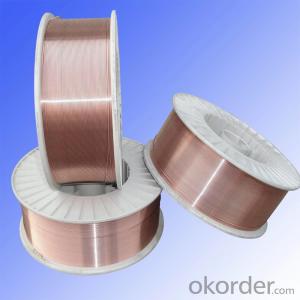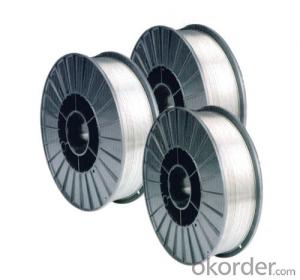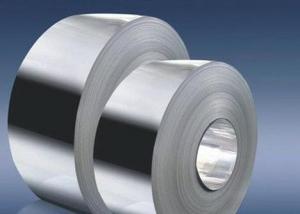Brass Steel Welding Wire/ Strip for Building
- Loading Port:
- Qingdao
- Payment Terms:
- TT OR LC
- Min Order Qty:
- 10 m.t.
- Supply Capability:
- 1000 m.t./month
OKorder Service Pledge
OKorder Financial Service
You Might Also Like
Brass Steel Welding Wire/ Strip for Building
Quick information:
AWS A5.18 ER70S-6
1) Copper coated
2) All position welding
3) Shield gas : CO2
4)Material: Carbon Steel
5)Diameter: 0.8mm-1.6mm
6)Weight: 15kg/spool, 100kg/barrel, 250kg/barrel
7)Flux Content: Without flux
8)Shield GAS: CO2
Specification:
| C | Mn | Si | S | P | Ni | Cr | Mo | V | Cu | |
| Standard | 0.06-0.15 | 1.40-1.85 | 0.80-1.15 | ≤0.035 | ≤0.025 | ≤0.15 | ≤0.15 | ≤0.15 | ≤0.03 | ≤0.50 |
| Typical | 0.078 | 1.53 | 0.85 | 0.01 | 0.011 | 0.029 | 0.022 | 0.008 | 0.010 | 0.12 |
Characteristics:
All products of welding wire were produced by German equipment.
Advanced technologies with advanced equipment.
FAQ:
Gas-shielded welding wires utilize Co2,argon-rich gas and argon gas as the shielding gases with high production efficiency.Large current may be used during welding to achieve droplet transfer,wiht large melting coefficient of wire, excellent depth of welding penetration on material, little melting residues,high-density current, concentrated heat, small heating area, little distortion of work pieces after welding, etc.
Because of low content of hydrogen in the seam,cold cracking is rare. Good visibility of electric arc facilitates full-position welding and welding at other positions.
Main Applications:Welding of various 500Mpa structural steel components;welding of various 500Mpa plates and pipes;full-position welding with a wide range of current.
Pictures:
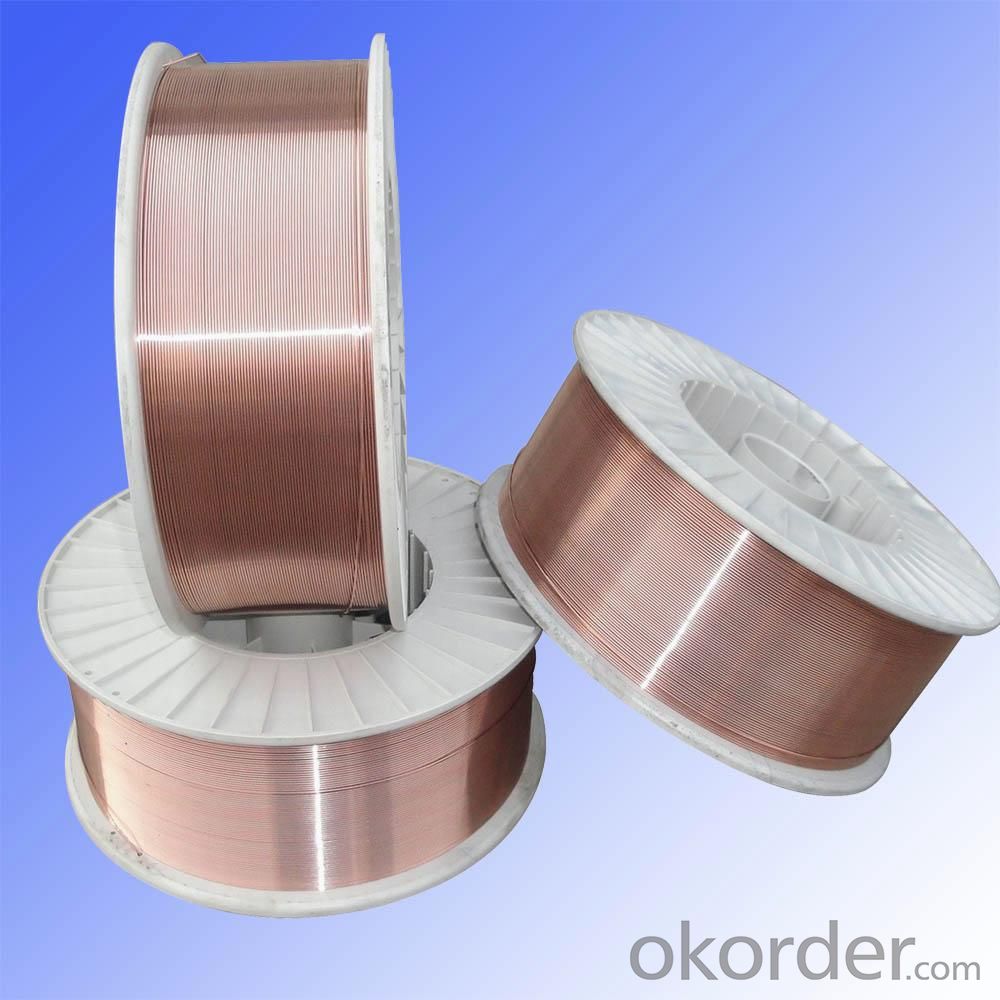
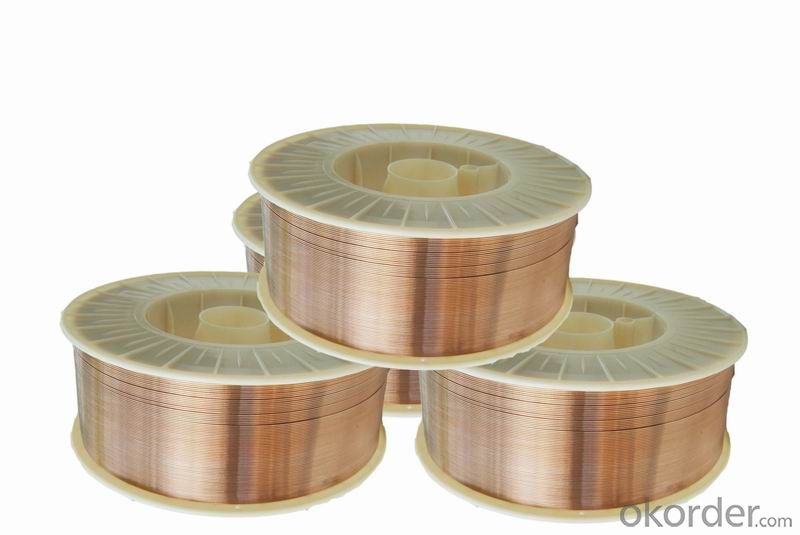
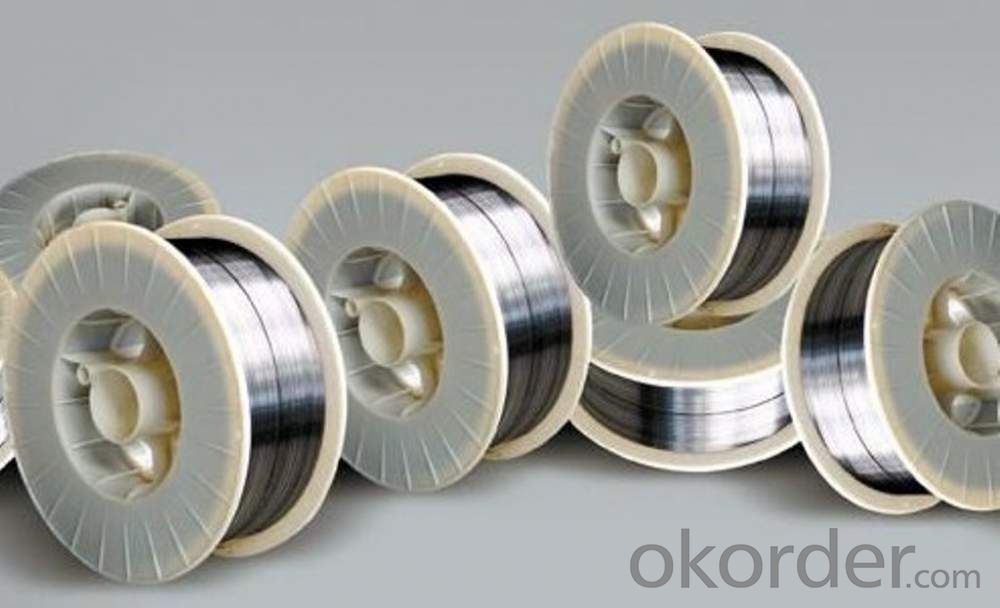
- Q:How does the composition of stainless steel affect its properties?
- The composition of stainless steel plays a crucial role in determining its properties. Stainless steel is primarily composed of iron, with varying amounts of chromium, nickel, and other elements. The presence of these elements alters the structure and chemical properties of the steel, resulting in unique characteristics. The most significant element in stainless steel is chromium, which provides corrosion resistance. When chromium content is at least 10.5%, it forms a protective layer on the surface of the steel, known as the passive film. This film prevents oxidation and corrosion, making stainless steel highly resistant to rust and staining. The addition of nickel enhances the corrosion resistance of stainless steel and improves its ductility. Nickel also enhances the stability of the austenitic structure, which is a non-magnetic phase of stainless steel that exhibits excellent toughness and high-temperature strength. Other elements, such as molybdenum, titanium, and copper, can be added to stainless steel to enhance specific properties. For example, molybdenum increases the resistance to pitting corrosion and improves the steel's performance in acidic environments. Titanium stabilizes the steel's structure and prevents sensitization, reducing the risk of intergranular corrosion. Copper improves the steel's resistance to sulfuric acid and certain other corrosive environments. Furthermore, the carbon content in stainless steel affects its strength and hardness. Low-carbon stainless steels are more ductile and have better weldability, while high-carbon steels are stronger but may be more prone to brittleness. In summary, the composition of stainless steel directly influences its properties. The addition of chromium, nickel, and other elements enhances corrosion resistance, strength, ductility, and other desirable characteristics. By carefully adjusting the composition, stainless steel can be tailored to meet specific requirements for various applications, such as in the automotive, aerospace, and construction industries.
- Q:What are the different types of stainless steel wire alloys?
- There are numerous types of stainless steel wire alloys available, each with their own unique properties and applications. Some common types include: 1. Austenitic Stainless Steel: This is the most common type of stainless steel wire alloy. It is known for its excellent corrosion resistance and high ductility. Austenitic stainless steel wire is often used in applications where superior strength and durability are required, such as in the construction industry. 2. Martensitic Stainless Steel: Martensitic stainless steel wire alloys have high hardness and strength, making them ideal for applications that require resistance to wear and abrasion. They are commonly used in the manufacturing of springs, surgical instruments, and cutting tools. 3. Ferritic Stainless Steel: Ferritic stainless steel wire alloys have good corrosion resistance and high temperature resistance. They are often used in applications where resistance to oxidation and stress-corrosion cracking is important, such as in automotive exhaust systems and heat exchangers. 4. Duplex Stainless Steel: Duplex stainless steel wire alloys combine the properties of both austenitic and ferritic stainless steels. They have excellent strength and corrosion resistance, making them suitable for applications in harsh environments, such as marine and offshore structures. 5. Precipitation Hardening Stainless Steel: Precipitation hardening stainless steel wire alloys are heat treatable and offer high strength and hardness. They are commonly used in aerospace and nuclear industries, where excellent mechanical properties are required. These are just a few examples of the different types of stainless steel wire alloys available. The choice of alloy depends on the specific application and the desired properties, such as corrosion resistance, strength, and temperature resistance. It is important to consult with a knowledgeable supplier or engineer to select the most suitable alloy for a particular application.
- Q:Can stainless steel wire be used for conveyor belts?
- Yes, stainless steel wire can be used for conveyor belts. Stainless steel wire is known for its strength, durability, and resistance to corrosion, making it an excellent material choice for conveyor belts. It can withstand high temperatures, heavy loads, and abrasive materials, making it suitable for various industries such as food processing, pharmaceuticals, automotive, and mining. Stainless steel wire conveyor belts are typically woven in a mesh pattern, allowing for efficient airflow and drainage while ensuring product stability and longevity. Additionally, stainless steel wire conveyor belts are easy to clean and maintain, making them a popular choice in industries where hygiene is crucial.
- Q:What are the different wire diameter tolerances for stainless steel wire?
- The tolerances for the diameter of stainless steel wire can differ based on the grade and application at hand. Typically, the range of tolerances for stainless steel wire diameter is between +/- 0.0002 inches to +/- 0.002 inches. Nevertheless, it is essential to acknowledge that these tolerances can vary depending on the manufacturing process and the intended purpose of the wire. In certain instances, stricter tolerances might be necessary for crucial applications that necessitate accurate measurements. Hence, it is vital to seek guidance from the manufacturer or supplier to ascertain the precise wire diameter tolerances for the individual stainless steel wire materials.
- Q:What's the difference between stainless steel screws and galvanized screws? Why are galvanized screws good?
- 3. Good reliability: the combination of zinc coating and steel is metallurgical bonding and becomes a part of the steel surface. Therefore, the durability of the coating is more reliable;4, coating toughness: zinc coating forming a special metallurgical structure, this structure can bear in transit and use mechanical damage;
- Q:Can stainless steel wire be used for cable railing systems?
- Indeed, cable railing systems can utilize stainless steel wire. The reason stainless steel is favored for cable railings is its exceptional robustness, ability to resist corrosion, and aesthetic attractiveness. This material is known for its strength and dependability, making it suitable for both indoor and outdoor settings, as it can withstand the elements. Moreover, stainless steel wire comes in various grades and finishes, granting the opportunity to personalize the railing system to achieve the desired appearance and style. Nevertheless, it is crucial to verify that the stainless steel wire meets the mandatory strength and safety criteria for cable railings.
- Q:Can stainless steel wire shelves be used for storage in wet environments?
- Yes, stainless steel wire shelves can be used for storage in wet environments. Stainless steel is highly resistant to corrosion and rust, making it ideal for use in areas with high moisture or humidity levels. It is a durable and hygienic material that can withstand exposure to water without deteriorating or causing any damage to the stored items.
- Q:Can stainless steel wire be used for guitar strings?
- Yes, stainless steel wire can be used for guitar strings. In fact, stainless steel is a popular choice for guitar strings due to its durability, bright tone, and resistance to corrosion. Stainless steel strings offer a distinct sound characterized by increased sustain, clarity, and a well-defined high-end response. These strings are particularly favored by players who prefer a more aggressive, bright, and punchy tone. However, it is important to note that the choice of guitar strings is subjective, and personal preference plays a significant role in selecting the right strings for individual playing styles and musical genres.
- Q:How are stainless steel wire shelves used in commercial kitchens?
- Stainless steel wire shelves are commonly used in commercial kitchens to provide efficient storage and organization solutions. They can be installed above workstations or near cooking areas to hold various kitchen tools, utensils, and ingredients. These shelves are sturdy, easy to clean, and resistant to corrosion, making them ideal for a busy kitchen environment. Additionally, their open wire design allows for proper air circulation, preventing the accumulation of dust and facilitating faster drying of items.
- Q:Can stainless steel wire be used for making wire traps?
- Certainly! Wire traps can indeed be made using stainless steel wire. This material, known for its strength and durability, is highly capable of enduring even the harshest outdoor conditions. Thanks to its resistance to rust and corrosion, it is well-suited for constructing traps that will be exposed to moisture. Moreover, the flexibility and ease of manipulation of stainless steel wire enable the crafting of intricate trap designs.
1. Manufacturer Overview |
|
|---|---|
| Location | |
| Year Established | |
| Annual Output Value | |
| Main Markets | |
| Company Certifications | |
2. Manufacturer Certificates |
|
|---|---|
| a) Certification Name | |
| Range | |
| Reference | |
| Validity Period | |
3. Manufacturer Capability |
|
|---|---|
| a)Trade Capacity | |
| Nearest Port | |
| Export Percentage | |
| No.of Employees in Trade Department | |
| Language Spoken: | |
| b)Factory Information | |
| Factory Size: | |
| No. of Production Lines | |
| Contract Manufacturing | |
| Product Price Range | |
Send your message to us
Brass Steel Welding Wire/ Strip for Building
- Loading Port:
- Qingdao
- Payment Terms:
- TT OR LC
- Min Order Qty:
- 10 m.t.
- Supply Capability:
- 1000 m.t./month
OKorder Service Pledge
OKorder Financial Service
Similar products
New products
Hot products
Hot Searches
Related keywords

